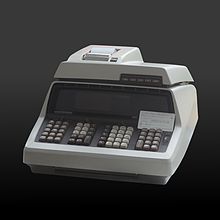
"The new Hewlett-Packard 9100A personal computer" is "ready, willing, and able... to relieve you of waiting to get on the big computer."
[1]The Hewlett-Packard 9100A is an early computer (or programmable calculator), first appearing in 1968. HP called it a desktop calculator because, as Bill Hewlett said, "If we had called it a computer, it would have been rejected by our customers' computer gurus because it didn't look like an IBM. We therefore decided to call it a calculator, and all such nonsense disappeared."[1]
History
The unit was descended from a prototype "green machine" produced by engineer Tom Osborne, who joined the company when HP decided to adopt the project.[2]
An engineering triumph at the time, the logic circuit was produced without any integrated circuits, the assembly of the CPU having been entirely executed in discrete components. With CRT readout, magnetic card storage, and printer, the price was around $5,000 ($33,000 today).
The 9100A was the first scientific calculator by the modern definition (i.e. trig, log/ln, and exponential functions), and was the beginning of Hewlett-Packard's long history of using reverse Polish notation entry on their calculators.
Due to the similarities of the machines, Hewlett-Packard was ordered to pay about $900,000 in royalties to Olivetti after copying some of the solutions adopted in the Programma 101, like the magnetic card and the architecture, in the HP 9100.
References
External links